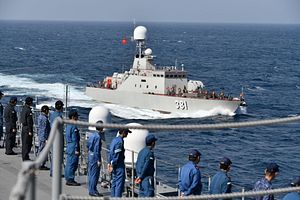The Vietnam People’s Navy (VPN) and the Japan Maritime Self-Defense Force (JMSDF) held a joint naval exercise off the southeastern coast of Vietnam on June 17, the JMSDF said in a recent statement.
The exercise involved tactical maneuvers, search-and-rescue drills, and communications training, according to the JMSDF, which dubbed the bilateral engagement a “goodwill exercise.” The aim of the bilateral drill was to improve the “tactical skills” of both navies and to strengthen the bilateral partnership.
The exercise, which was held off the strategically important Cam Ranh International Port, home to a naval maintenance and logistics facility, involved a VPN missile corvette (pennant number 381) and the first-of-class flattop JS Izumo and the Murasame-class destroyer JS Murasame.
The exercise took place after the JMSDF ships’ depature from Cam Ranh on June 17, following a three-day port call that began on June 14. The brief visit included senior VPN personnel touring the JS Izumo, cultural exchanges, sporting events, and a press conference by the JMSDF carrier group commander. JMSDF personnel also visited the Vietnam Naval Academy.
The visit and bilateral naval exercise highlight the deepening military links between Japan and Vietnam as part of their so-called extensive strategic partnership, which is largely driven by China’s growing military power and increased assertiveness in the region. China’s continued militarization of the South China Sea is of particular concern to Vietnam, as it is locked in a maritime dispute with Beijing.
As my colleague Prashanth Parameswaran pointed out, recent advances in the bilateral relationship “have included not just headline items such as periodic maritime security assistance, but significant moves including new naval drills, Japanese port calls, an agreement on coast guard cooperation, and discussions on more defense equipment and defense industrial collaboration.”
Last month, Japan’s Defense Minister Takeshi Iwaya paid a visit to Vietnam to sign a memorandum of understanding to strengthen defense industry cooperation between the two countries.
The Indo-Pacific deployment of the JS Izumo and its escort, which includes the JS Murasame and the Murasame-class destroyer JS Akebone, began April 30 and runs through July 10. During its deployment, the Japanese warships have been engaging with a number of regional navies, as I explained:
Last month, ships of the Indian Navy engaged with the JS Izumo and JS Murasame in an anti-submarine warfare (ASW) drill in the Andaman Sea.
The Indo-Japanese drill was preceded by a JMSDF-U.S Navy cooperative deployment in the Malacca Strait involving the USS William P. Lawrence, a U.S. Navy Arleigh Burke-class guided-missile destroyer, the JS Izumo, and the JS Murasame on May 22.
The two JMSDF warships also participated in a multilateral naval engagement between May 2 and May 8 in the South China Sea.
The Japanese flotilla also conducted a naval exercise with the U.S. Navy Nimitz-class nuclear-powered aircraft carrier USS Ronald Reagan in the South China Sea from June 10 to 12. However, the JMSDF has not joined the U.S. Navy or other allied navies in conducting freedom of navigation operations in the contested waters to challenge Chinese territorial claims.

































